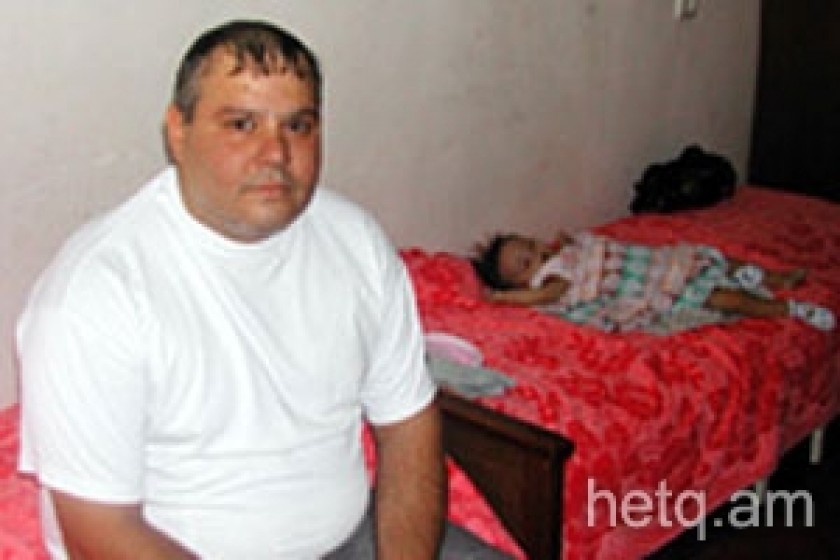
We Thought It Would Be Better in the Homeland
According to information from the Ministry of Foreign Affairs of Armenia, because of the war in Lebanon, 774 citizens of that country arrived to take refuge in Armenia over the summer months. Most of them are ethnic Armenians. Some of them have already returned home; the others remain in uncertainty.
“I haven't decided yet what I'm going to do. I worked as a jeweler in Lebanon but now there is no job there. The war has turned everything upside down,” said Lebanese Armenian Abraham Chaparyan says. The Chaparyan family arrived in Armenia on August 3, 2006. The Migration Agency issued residency cards for them and provided them with shelter for three months. Now Abraham, his wife and two children (five and nine years old) live in one room in Building #1 of the Nork dormitory.
“I went to a hospital in Lebanon to treat my back but the next morning the war started and I was discharge from the hospital to vacate the room for the wounded. My youngest son has a heart condition; he was terrified by the noise. So we had to hastily gather whatever we could take with us and come to Armenia via Aleppo,” Abraham said. Abraham has not received any medical treatment in Armenia. The Migration Agency suggested going to the Red Cross for help.
The Chaparyans' neighbors, the Guyumjyan family, who had lived in Lebanon for fifteen years before coming to Armenia, are in the same uncertain situation.
“I would like to stay here but I need to find a job. I'm an accountant by training but I haven't worked as one for many years. Now the accounting methods have changed so much that I'm not sure I can work,” Anahit Guyumjyan said.
In Lebanon Anahit's husband was engaged in masonry. They had a house and a car, and now their major worry is that their house might be occupied by refugees and they won't be able to move them out.
“Now we can't decide what to do. We've gone through our savings and we can't find work.”
The shelters provided to Armenians from Lebanon consist of one room, which serves as living room, bedroom, and closet. There is a common kitchen and bathroom. They are given an allowance – 13,000 drams a month, irrespective of the number of the family members.
When asked why they came to Armenia over another country they said: “We thought it would be better in the homeland.”
According to the Migration Agency only 301 people of those who came to Armenia during the Israel-Lebanon conflict have applied for residency status – 51 Israelis and 250 Lebanese (230 Armenians, 15 Arabs or Assyrians). It is not known how many of them have already left, since when they do they don't inform anyone of their departure.
“They say that at that time they were only able to come to Armenia. They all hope that soon everything will be over and they will return home. Of course, it would be desirable for them, since not all of them are able to adjust here. For those who are natives of Lebanon, everything is alien here, the Armenians who had moved there have already become accustomed to the life there and, not surprisingly, want to return,” explained Ruzan Petrosyan, the head of the department of asylum seekers of the Migration Agency.
Lebanese-Armenian Anahit Guyumjyan said that they had had no other choice but to come to Armenia. The other routes were closed. Only ethnic Lebanese were able to go to the United States, Canada and European countries.
“For some reason these people view Armenia as a transit country. There was a Lebanese man who specially came here to go to Holland. He said that from his country it was harder and more expensive. But I don't know how they decided that it was easier or cheaper from here,” Ruzan Petrosyan said.
The majority of those who came here are staying with relatives or friends, some have rented apartments, and three families are in the dormitory. According to Ruzan Petrosyan, they might stay here forever: “If they decide to stay they should take into consideration that the dormitory is provided for three months and they should find apartments to live in.”
Individuals who come from a country where their life is in danger are granted asylum for one year. If conflicts in those countries continue, this period can be extended. But no matter what the circumstances, shelter is provided for three months. According to regulations, at first each asylum seeker is given a temporary card which is valid for three months. If the conditions in the home country do not change, they can extend the residency card up to one year.
There is also a special residency status for ten years. It is given to ethnic Armenian citizens of foreign countries if they wish to stay in Armenia for a long period of time. They receive a passport with a stamp indicating special residency status. The issuance of this document costs $300.
According to the Migration Agency, over the last few years the number of people seeking asylum in Armenia has increased sharply. The first mass inflow began during the war in Iraq. 399 Iraqi citizens came to Armenia in 2000-2006; they too are mostly Armenian.
 Videos
Videos Photos
Photos




Write a comment